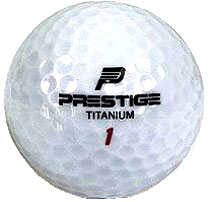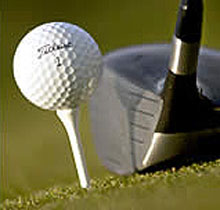 Golf
balls are made to meet specifications laid down by two controlling
bodies which are the Royal & Ancient Golf Club of St. Andrews (R &
A) and the United States Golf Association (USGA). Both bodies specify
that the ball must weigh not more than 45.9 g (1.62 oz) but the specification
for diameter differs as follows: Golf
balls are made to meet specifications laid down by two controlling
bodies which are the Royal & Ancient Golf Club of St. Andrews (R &
A) and the United States Golf Association (USGA). Both bodies specify
that the ball must weigh not more than 45.9 g (1.62 oz) but the specification
for diameter differs as follows:
R & A Not less than 41.15 mm (1.62 in)
USGA Not less than 42.67 mm (1.68 in)
The USGA additionally specifies that the golf ball must not leave
a projection apparatus of their own design at a speed greater than
77.8 m/s (225 ft/s), and this sets an upper limit on resilience for
the 42.67 mm ball.
The smaller and heavier a ball the further it will go. Manufacturers
(in particular, those making the 41.15 mm balls) are therefore encouraged
to make balls as near as possible to maximum weight and minimum size
allowable so as to achieve maximum flight length.
Ball structures break down broadly into two categories: wound balls,
which are the conventional ball and the solid ball. |
| |
| Conventional Golf Balls |
| Conventional Wound Golf Balls |
These balls are made from tightly stretched rubber
thread wound around one of two kinds of cores: a liquid centre,
where the core is liquid-filled; or a solid centre, in which
the core is made of synthetic rubber. The ball is completed
by molding on a protective cover, which incorporates the surface
pattern. Generally, this ball excel in spin performance, but
fall short in terms of distance and durability. |
| Solid Golf Balls |
| One-piece balls |
These balls are made of a single, high-restitution synthetic
rubber Because these balls deform to a large degree at impact,
they lose a great deal of the energy required for carry and
consequently offer less distance than balls built with different
structures. Primarily used for driving-range |
| Two-piece balls |
These balls consist of a cover and a solid core. This configuration
enables the energy at impact to be transferred efficiently to
the ball in flight. Because the cover itself is made of a high-restitution
material, these balls generate excellent distance. |
| Three-piece or multi-layer balls |
These are multi-layer balls in which the core material is
wrapped in multiple covers. As a result of the latest advances
in technology, manufacturers are now able to flexibly combine
materials, degrees of hardness, specific gravity, and so on,
in ways that enhances a variety of performance features. |
| |
|
|
Manufacturing
Process
 Core
Material Core
Material
Golf balls consist of two parts, core and the cover. The core can
be made from rubber or thermoplastic elastomer compound. It is then
wound with thread and the winding process dictates the velocity of
the ball's core. The core can also be made with just the rubber without
the wounded thread. However the formulation of the ingredients blended
into the solid core is critical to the velocity of the golf ball.
The solid core is a high-resiliency rubber compound with blends of
natural and synthetic rubber. The compound is extruded, rolled and
cut into sheets, extruded into blanks and moulded into spheres. At
the final core finishing, every core is ground with a centerless grinding
machine (similar to billiard balls manufacturing).
Cover Material
The cover materials can be made from elastomer or thermoplastic material.
The elastomer cover material provides a soft feel and spin as well
as durability. As for the thermoplastic resin cover, this material
offers excellent cut and abrasion resistance and available in a wide
range of hardness and flexibility. Blends of thermoplastic can also
be used to vary the performance options in spin rate, feel and durability.
Performance characteristics are from high spin/soft feel to low spin/longer
distance.
Moulding Process
Two processes can be used, injection and compression moulding. In
the injection moulding process, the core is held within a mould cavity
by pins. The cover material (thermoplastic) is injected into the cavity
and the blend is melted with heat and pressure and then injected into
a cold mould where it freezes into the cup shape. As the resin begins
to cool and harden, the pins are retracted. After the resin has sufficiently
cooled, the moulded ball is ejected from the mould.
In the compression moulding, the resin is first formed into half-shells
and assembled around either a wound centre or a solid core. The assemblies
are then placed in a mould and subjected to high pressure and temperatures.
During this stage, the half-shells are fused together and the dimples
are pressed into the cover materials. This method yields more consistent
core centering, fewer cosmetic defects and more uniform product.
Finishing
Some materials require painting but thermoplastic resins can be blended
with colours during the processing to give the desired colour.

|




